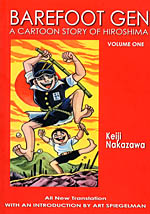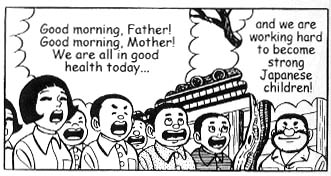 By Keiji Nakazawa
By Keiji Nakazawa
288 pages, black and white
Published by Last Gasp
There are sacred cows in all genres and groupings of comics, those works that if you haven’t read you’ll get a funny look (at best) by way of response. Over the years, one of the works I’ve meant to try out is Barefoot Gen, Keiji Nakazawa’s autobiographical account of living through the atomic bombing of Hiroshima. Earlier this year I finally broke down and picked up the first of its ten volumes. What I found inside was, well, not quite what I was expecting.
In World War II Hiroshima, Gen’s family are outcasts. His father Daikichi Nakaoka is against the war, and in 1945 that simply wasn’t allowed. Their family’s crops are destroyed, the shoes made for the market are thrown into the river and made unusable, and they are continually tormented and mocked by the rest of Hiroshima’s citizens. Even the oldest son of the family enlisting in the armed forces isn’t enough to stem the tide of hatred because the Nakaoka family won’t fall in line and declare the war to be a good thing. Just when things couldn’t seem to get any worse, though, the United States drops the atomic bomb on Hiroshima, and everything radically changes.
 I understand that Barefoot Gen was originally created in the early 1970s, when manga in Japan had a different style and accepted mood. So it’s with a grain of salt that I had to accept the fact that as a storyteller, Nakazawa’s work wasn’t really my cup of tea. Like The Drifting Classroom, everything in Barefoot Gen seems overly intense and in-your-face. Even before the bomb finally drops, every single setback is suddenly the end of the world for Gen (Nakazawa’s autobiographical stand-in) and the rest of his family. At first, it’s somewhat understandable. There’s no food to eat. The shoes are destroyed. The crops are ruined. But as the book goes on, the breaking point for Gen and his siblings is on a sliding scale into ludicrousness. Gen’s little brother Shinji wanting a toy battleship isn’t something you can really get worked up over, but the intensity never dies down. By the time the bomb does drop at almost the very end of the first volume, you’ve become somewhat immune to Gen’s wailing and screaming—and right as something truly horrific does in fact happen. It’s worn the reader down so much that it actually makes the bomb’s destruction and death lose some impact because you’ve already dealt with 250 pages of Gen wailing.
I understand that Barefoot Gen was originally created in the early 1970s, when manga in Japan had a different style and accepted mood. So it’s with a grain of salt that I had to accept the fact that as a storyteller, Nakazawa’s work wasn’t really my cup of tea. Like The Drifting Classroom, everything in Barefoot Gen seems overly intense and in-your-face. Even before the bomb finally drops, every single setback is suddenly the end of the world for Gen (Nakazawa’s autobiographical stand-in) and the rest of his family. At first, it’s somewhat understandable. There’s no food to eat. The shoes are destroyed. The crops are ruined. But as the book goes on, the breaking point for Gen and his siblings is on a sliding scale into ludicrousness. Gen’s little brother Shinji wanting a toy battleship isn’t something you can really get worked up over, but the intensity never dies down. By the time the bomb does drop at almost the very end of the first volume, you’ve become somewhat immune to Gen’s wailing and screaming—and right as something truly horrific does in fact happen. It’s worn the reader down so much that it actually makes the bomb’s destruction and death lose some impact because you’ve already dealt with 250 pages of Gen wailing.
 The thing is, Nakazawa’s depiction of the destruction of Hiroshima is stomach-turning. It’s easily the most powerful section of the first volume, as fires rage out of control even while family members and friends are pinned under collapsed houses and slowly die. I understand why Nakazawa took so long to get to this moment, so you can see what their life was leading up to that moment, but Nakazawa overplays his hand a bit. The art helps somewhat here, with Nakazawa’s normally pinched faces of his characters looking more open and terrified than ever before. Up until this point I’d slightly written off Nakazawa’s art as overly simplistic and stiff, but things loosen up a little bit here. The burning, ruined Hiroshima works in a way that Nakazawa’s dozen or so poses used over and over again never did.
The thing is, Nakazawa’s depiction of the destruction of Hiroshima is stomach-turning. It’s easily the most powerful section of the first volume, as fires rage out of control even while family members and friends are pinned under collapsed houses and slowly die. I understand why Nakazawa took so long to get to this moment, so you can see what their life was leading up to that moment, but Nakazawa overplays his hand a bit. The art helps somewhat here, with Nakazawa’s normally pinched faces of his characters looking more open and terrified than ever before. Up until this point I’d slightly written off Nakazawa’s art as overly simplistic and stiff, but things loosen up a little bit here. The burning, ruined Hiroshima works in a way that Nakazawa’s dozen or so poses used over and over again never did.
I feel bad for not liking the majority of Barefoot Gen Vol. 1, because the story that it’s telling is certainly an important one, and I’m imposing a modern sensibility on a comic created over 35 years ago. I appreciate that Last Gasp brought this work back into print, although I do question the usage of the Comics Sans font to letter the book. Maybe later volumes will be more palatable now that it’s telling a story where the stakes really are that much higher. But as a modern reader going into Barefoot Gen cold, the book left me sadly unimpressed.
Purchase Links: Amazon.com | Powell’s Books
